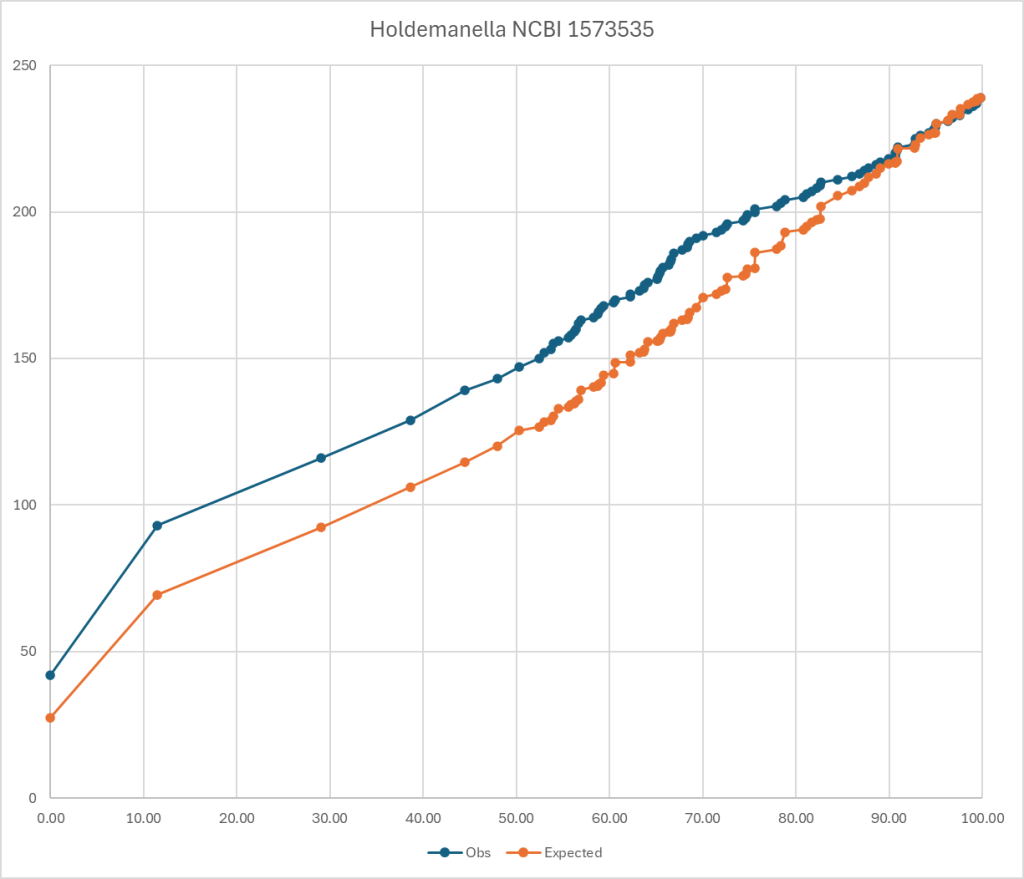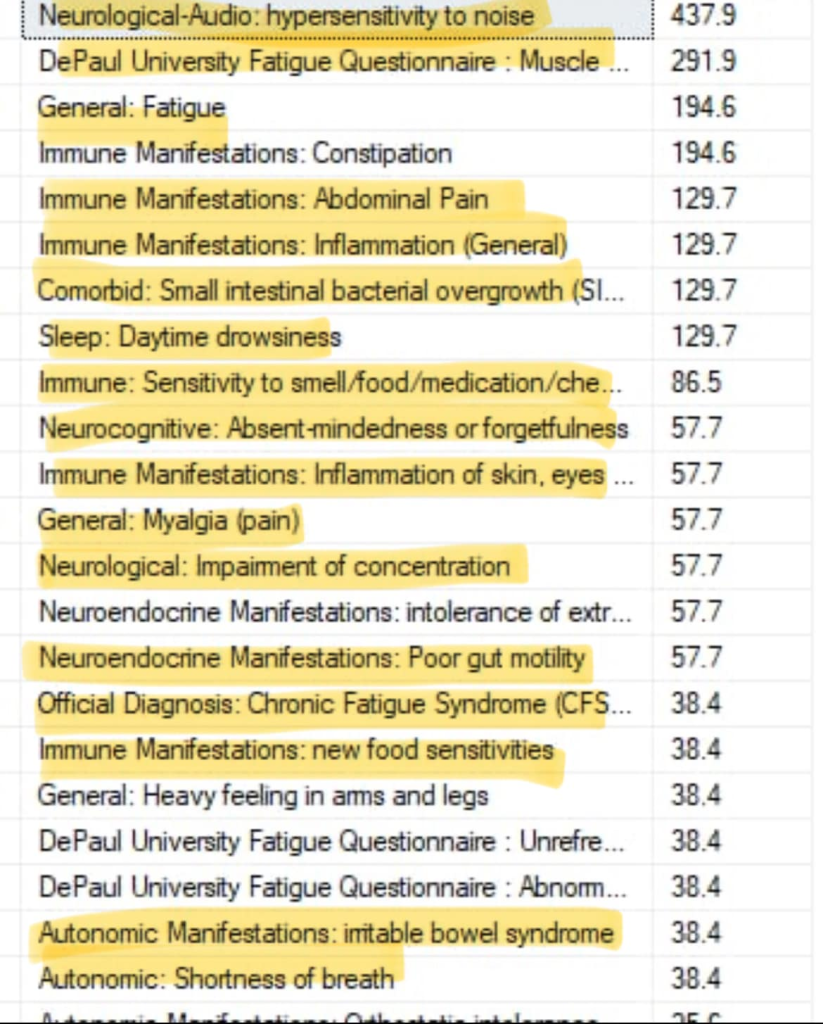This is a preview of the next generation of analysis. I described a mathematical model in Microbiome Guilds, Metabolites and Enzymes. I mentioned a concept in it and over the weekend tried the concept out. It worked and is very sweet.
To explain it, look at the chart below. The blue line is for those that have a symptom and the orange line is what is expected. If you divide observed by expected for different percentiles, you get an odds ratio. Most people know odds ratio (OR) from things like:
For current male smokers consuming >30 cigarettes daily:
- Squamous Cell Carcinoma (SqCC): OR = 103.5
- Small Cell Lung Cancer (SCLC): OR = 111.3
- Adenocarcinoma (AdCa): OR = 21.91
This pattern does not determine that you will absolutely get it. It means that your are more likely — odds. (My native environment as a statistican)

Biomesight Bacteria
The genus bacteria listed below, each have at least an odds ratio of 1.5 for general fatigue using Biomesight data if your percentile is below the amount show. I stopped listing at 10%ile items
- Bifidobacterium <= 48.7
- Collinsella <= 41
- Coprococcus <= 39.3
- Desulfosporosinus <= 38.7
- Lachnobacterium <= 37.6
- Oribacterium <= 35.8
- Lactobacillus <= 30.5
- Pseudobutyrivibrio <= 29.5
- Legionella <= 28.9
- Roseburia <= 28.3
- Faecalibacterium <= 27.8
- Lachnospira <= 27.3
- Turicibacter <= 27.1
- Mycoplasma <= 25.8
- Peptococcus <= 24.3
- Coraliomargarita <= 23.8
- Sedimentibacter <= 23.7
- Rhodothermus <= 23
- Tindallia <= 22.4
- Thiothrix <= 21.8
- Eubacterium <= 21.7
- Thermicanus <= 21.6
- Sutterella <= 21.5
- Alkaliphilus <= 21.5
- Luteibacter <= 21.1
- Sphingobacterium <= 21.1
- Candidatus Phytoplasma <= 20.5
- Anaerostipes <= 20.4
- Haemophilus <= 19.9
- Moorella <= 19.1
- Catenibacterium <= 18.7
- Olivibacter <= 18.5
- Novispirillum <= 18.4
- Butyricimonas <= 18.3
- Natronincola <= 17.9
- Macrococcus <= 17.3
- Runella <= 16.6
- Tepidanaerobacter <= 16.1
- Caldicellulosiruptor <= 15.7
- Enterococcus <= 15.4
- Serratia <= 15.3
- Salinicoccus <= 15.2
- Gemella <= 14.9
- Odoribacter <= 14.7
- Thiohalorhabdus <= 14.6
- Dorea <= 14.2
- Escherichia <= 14.1
- Chlorobaculum <= 14
- Parabacteroides <= 14
- Calothrix <= 13.8
- Megasphaera <= 13.8
- Selenomonas <= 13.6
- Acetobacterium <= 13.6
- Slackia <= 13.4
- Pseudoclostridium <= 13.4
- Peptoniphilus <= 12.4
- Tetragenococcus <= 12.2
- Johnsonella <= 12
- Akkermansia <= 11.8
- Veillonella <= 11.5
- Holdemanella <= 11.5
- Streptococcus <= 11.2
- Pectinatus <= 11.2
- Pedobacter <= 11.1
- Klebsiella <= 11
- Dysgonomonas <= 11
- Erysipelothrix <= 10.9
- Desulfurispora <= 10.7
- Dolichospermum <= 10.5
- Mogibacterium <= 10.4
- Bilophila <= 10.2
- Ruminiclostridium <= 10.2
- Finegoldia <= 10.1
If you have 10 of them then 1.5 ^ 10 = 57x greater odds of having general fatigue. It is NOT one bacteria causing it, or even a specific group of bacteria, but different combinations of possible bacteria.
I should mention that these numbers only applies to Biomesight data. “results from one pipeline cannot be safely applied to another“. For background see: The taxonomy nightmare before Christmas.
Ombre Equivalent Bacteria
If you have Ombre’s microbiome results, these are the critical bacteria:
- Collinsella <= 44.2
- Erysipelatoclostridium <= 41.8
- Bifidobacterium <= 41.1
- Thomasclavelia <= 39.2
- Lactobacillus <= 30.1
- Dorea <= 27.4
- Fusicatenibacter <= 24.1
- Gemmiger <= 23
- Terrisporobacter <= 17.9
- Sutterella <= 16.1
- Coprobacter <= 15
- Coprococcus <= 13.7
- Haemophilus <= 13.6
- Flavonifractor <= 13
- Casaltella <= 13
- Ruminiclostridium <= 12.5
- Faecalicatena <= 12.3
- Mediterraneibacter <= 11.9
- Slackia <= 11.8
- Paraprevotella <= 11.5
- Eubacterium <= 11.3
- Subdoligranulum <= 11.2
- Lachnospira <= 10.3
- Phocaeicola <= 10.2
uBiome Equivalent Bacteria
This illustrates well the fact that ranges will differ a lot between tests.
- Subdoligranulum <= 43
- Faecalibacterium <= 38.9
- Pseudobutyrivibrio <= 26.2
- Veillonella <= 22.4
- Dorea <= 21.4
- Fusicatenibacter <= 21.1
- Hespellia <= 19
- Oscillibacter <= 18.6
- Roseburia <= 18.2
- Odoribacter <= 17.9
- Collinsella <= 15.9
- Intestinibacter <= 15.8
- Bifidobacterium <= 15.1
- Clostridioides <= 14.6
- Papillibacter <= 14.5
- Actinomyces <= 14.2
- Sutterella <= 12.9
- Blautia <= 12.8
- Parabacteroides <= 11.9
- Marvinbryantia <= 11.6
- Anaerotruncus <= 10.8
Bottom Line
This transforms the ability to determine if a bacteria is too high or low. Given a symptom or condition, we can determine the bacteria likely involved and if the level is likely (odds) to contribute to the symptom.
We can thus focus on exactly the bacteria of concern and ifnore the noise elsewhere.
Stay tune, there is a lot of coding to do to implement this.
Trial of algorithm
I was helping someone transfer data from biomesight.com and decided to run their latest sample thru the odds ratio I had derived this weekend. She marked their symptoms, see below. The numbers are the odds ratio.

The evidence that hypersensitivity to noise is likely microbiome dysfunction based is sweet — since there is no conventional treatment for it.
Recent Comments